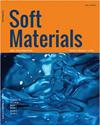氨基酸基双尿素化合物在有机溶剂和表面活性剂存在下的凝胶特性
IF 1.4
4区 材料科学
Q4 MATERIALS SCIENCE, MULTIDISCIPLINARY
引用次数: 0
摘要
基于低分子量凝胶(LMWGs)和胶束形成表面活性剂的自组装体系通过非共价和非干扰相互作用来稳定。低分子微分子分子和表面活性剂在溶液中同时自组装,可以形成含有表面活性剂胶束的纤维状网络。在本研究中,研究了氨基酸衍生的低分子量双尿素化合物在水、各种有机溶剂和表面活性剂溶液中的凝胶性,包括阴离子表面活性剂十二烷基硫酸钠和十二烷基苯磺酸、阳离子表面活性剂西曲溴铵、非离子表面活性剂聚山梨酸酯80和辛基-β-d-葡萄糖吡喃苷。在表面活性剂存在的情况下,双尿素化合物的连接性质影响凝胶分子之间的聚集。当表面活性剂浓度高于临界胶束浓度(CMC)时,环状和芳香连接剂的化合物可有效形成凝胶。基于成像分析观察到表面活性剂凝胶的不同纤维形态,表明双尿素化合物的结构影响自组装。流变学测量揭示了凝胶的固体性质及其高热稳定性。表面活性剂凝胶的粘弹性在各种商业应用中提供了潜在的用途,包括家庭护理产品。本文章由计算机程序翻译,如有差异,请以英文原文为准。
Gelation properties of amino-acid-based bis-urea compounds in organic solvents and in the presence of surfactants
ABSTRACT Self-assembled systems based on low-molecular-weight gelators (LMWGs) and micelle-forming surfactants are stabilized by non-covalent and non-interfering interactions. The simultaneous self-assembly of LMWGs and surfactants in a solution could lead to the formation of fibrillar networks with encapsulated surfactant micelles. In this study, the gelation properties of amino-acid-derived low-molecular-weight bis-urea compounds in water, various organic solvents, and surfactant solutions, including anionic surfactants sodium dodecyl sulfate and dodecylbenzene sulfonic acid, cationic surfactant cetrimonium bromide, and nonionic surfactants polysorbate 80 and octyl-β-d-glucopyranoside, were investigated. In the presence of surfactants, the nature of the linker of the bis-urea compounds influences the aggregation between gelator molecules. Compounds with cyclic and aromatic linkers effectively form gels at surfactant concentrations above a critical micelle concentration (CMC). The different fiber morphologies observed for surfactant gels based on imaging analysis suggest that the structure of the bis-urea compounds influences self-assembly. Rheological measurements revealed the solid-like nature of the gels and their high thermal stability. The viscoelastic nature of the surfactant gels offers potential use in various commercial applications, including home care products.
求助全文
通过发布文献求助,成功后即可免费获取论文全文。
去求助
来源期刊

Soft Materials
工程技术-材料科学:综合
CiteScore
2.90
自引率
0.00%
发文量
21
审稿时长
2.2 months
期刊介绍:
Providing a common forum for all soft matter scientists, Soft Materials covers theory, simulation, and experimental research in this rapidly expanding and interdisciplinary field. As soft materials are often at the heart of modern technologies, soft matter science has implications and applications in many areas ranging from biology to engineering.
Unlike many journals which focus primarily on individual classes of materials or particular applications, Soft Materials draw on all physical, chemical, materials science, and biological aspects of soft matter. Featured topics include polymers, biomacromolecules, colloids, membranes, Langmuir-Blodgett films, liquid crystals, granular matter, soft interfaces, complex fluids, surfactants, gels, nanomaterials, self-organization, supramolecular science, molecular recognition, soft glasses, amphiphiles, foams, and active matter.
Truly international in scope, Soft Materials contains original research, invited reviews, in-depth technical tutorials, and book reviews.
 求助内容:
求助内容: 应助结果提醒方式:
应助结果提醒方式:


